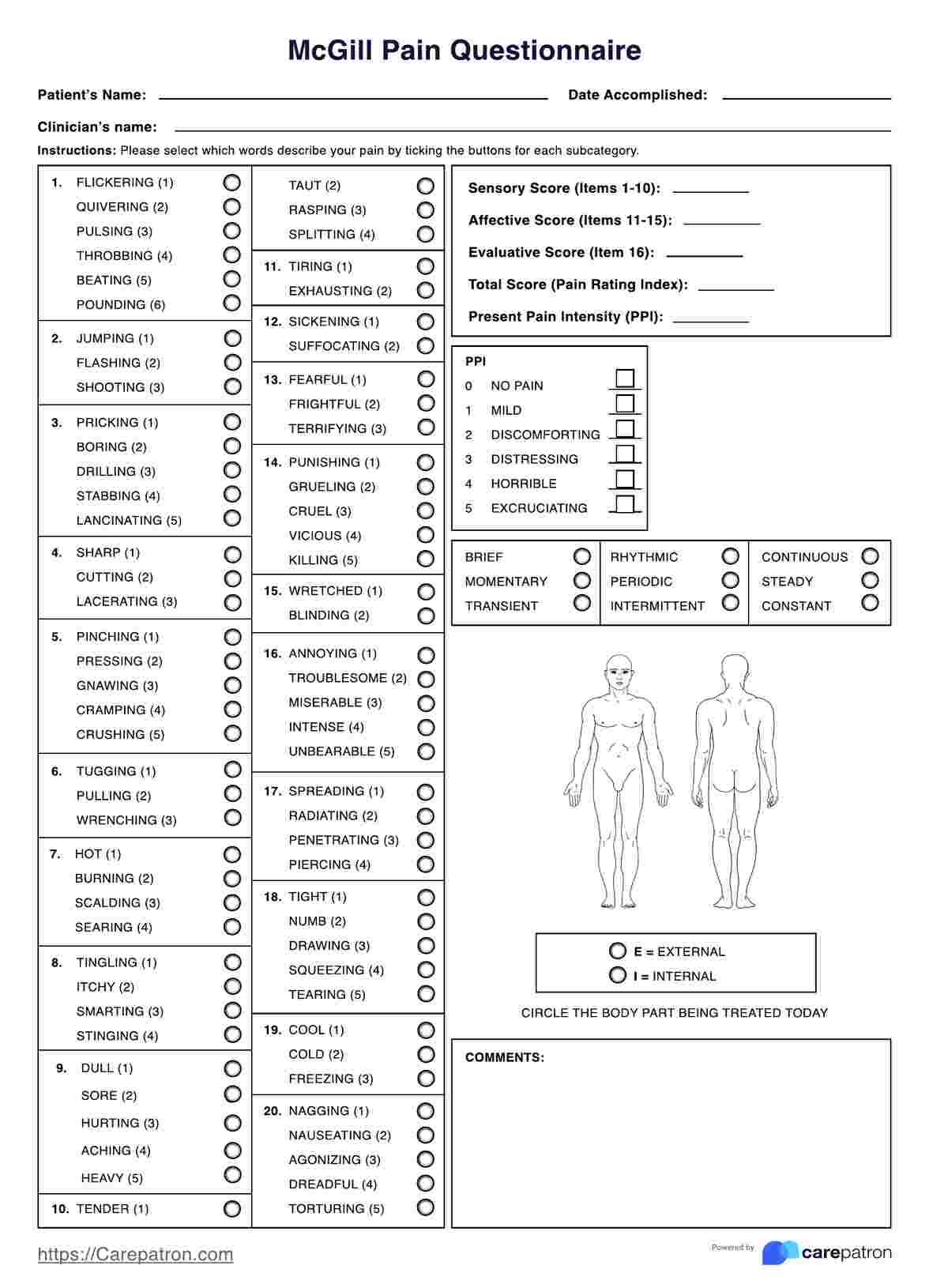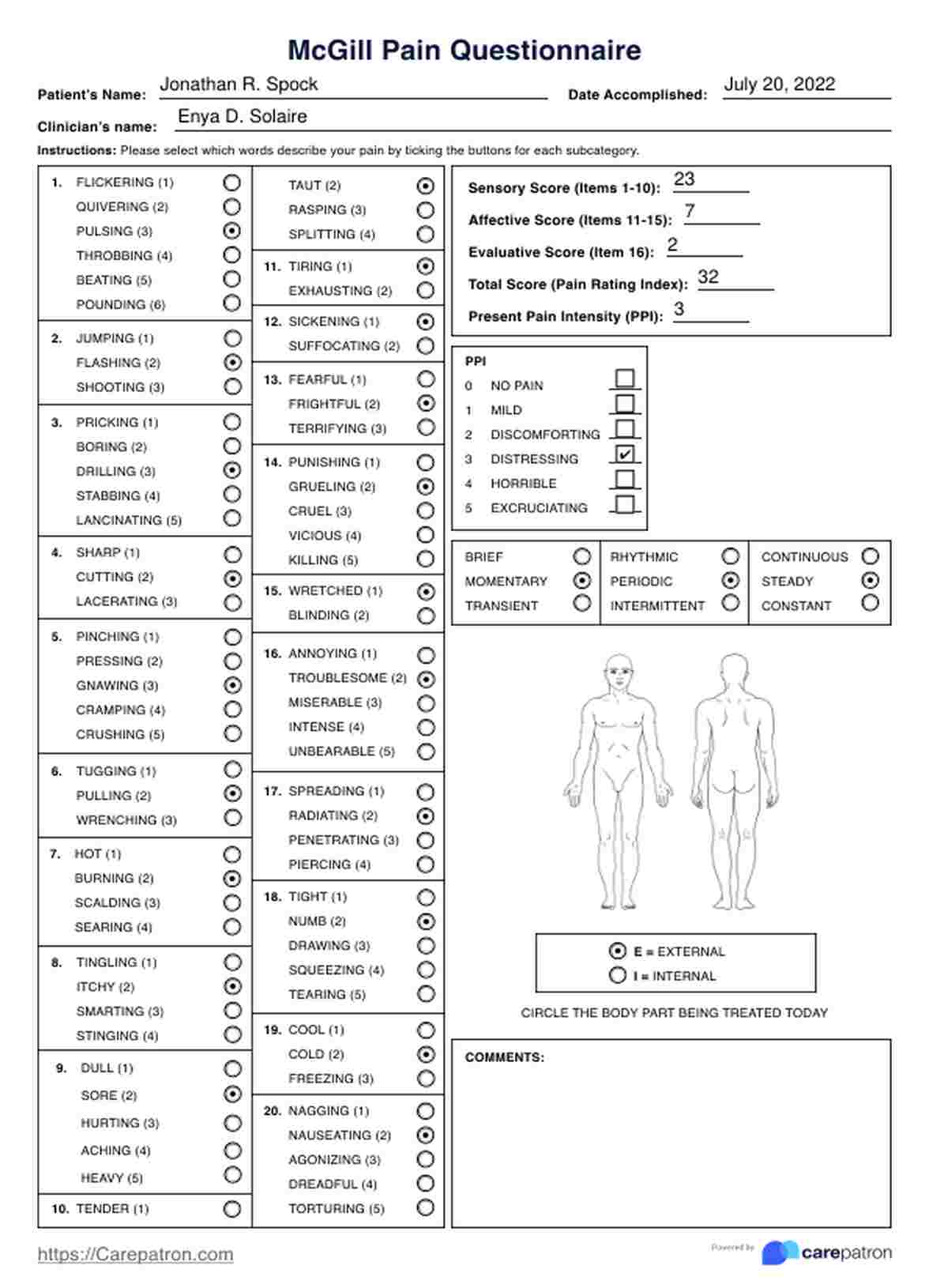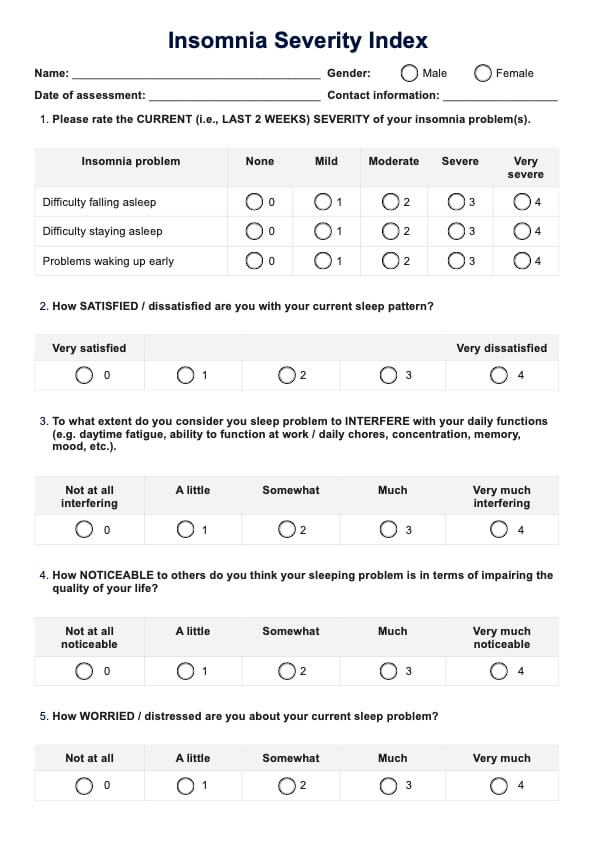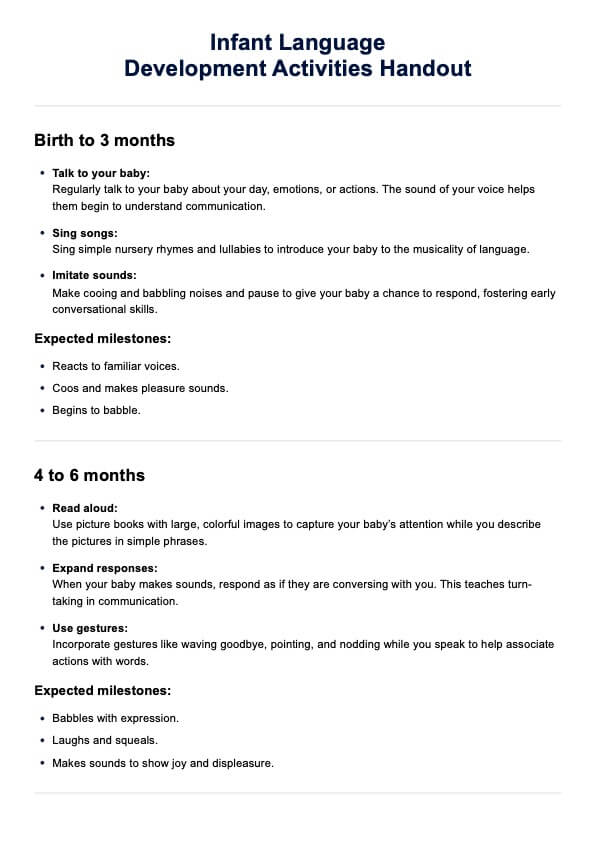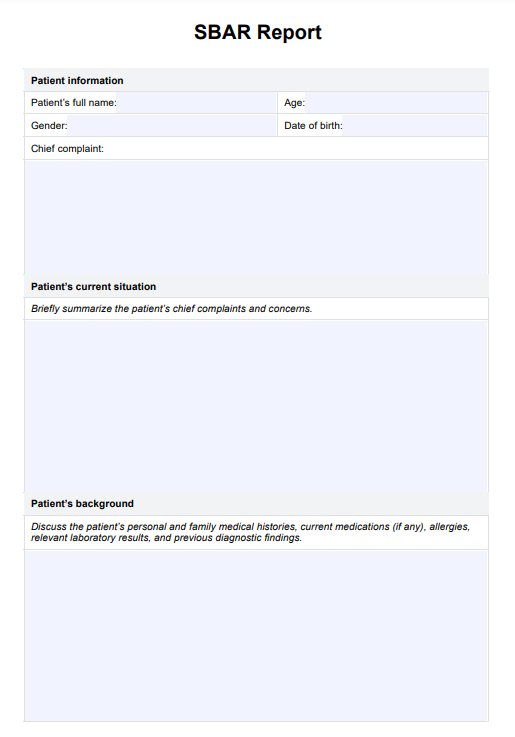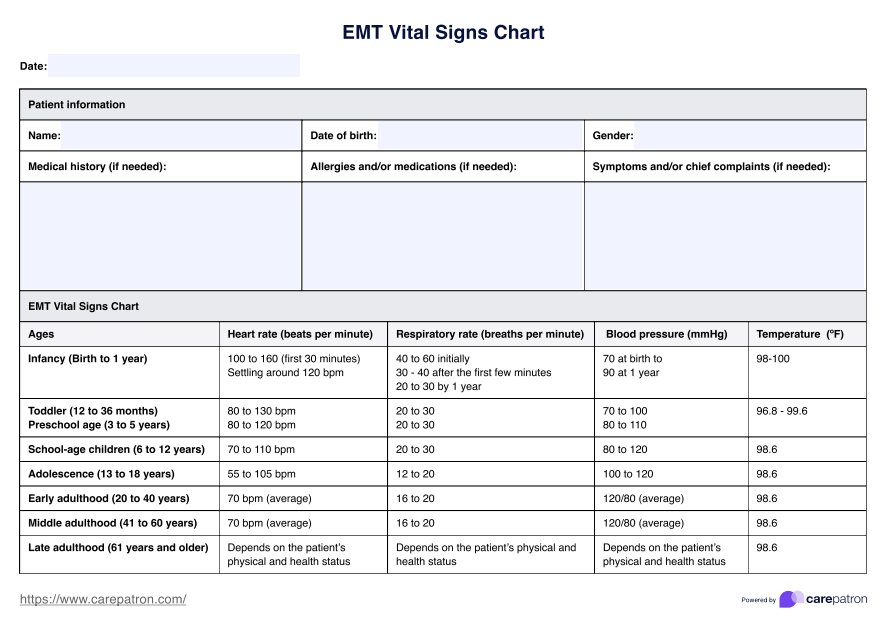McGill Pain Scale
If your patient is in pain, hand them the McGill Pain Scale, a self-assessment questionnaire, so they can rate themselves based on how they are feeling and how they view the pain they’re experiencing.


What is the McGill Pain Scale?
The McGill Pain Scale was developed in the 1970s by Dr. Ronald Melzack and Dr. Warren Torgerson. They named the scale after McGill University.
The scale comes in the form of a self-assessment questionnaire, and it aims to provide healthcare professionals with a multidimensional picture of the pain experienced by their patients.
A regular pain scale normally has a numerical rating between zero to ten, with zero meaning the patient doesn’t experience pain at all, and ten meaning they are experiencing the worst pain imaginable. It provides a general overview of how the patient feels and views their pain.
The McGill Pain Scale takes a step further by exploring the subjective aspects of pain. These are divided into three categories:
- Sensory - This category is composed of a selection of certain sensations that may describe what the patient feels while they are in pain.
- Affective - This category is about how the patient perceives the pain or how they feel about it.
- Evaluative - This category is about how the patient would describe their pain at its worst.
These categories are divided into seventy-eight items, and each category has sub-groups. These sub-groups are composed of adjectives. The patient only needs to select which adjective applies to them for each sub-group.
McGill Pain Scale Template
McGill Pain Scale Example
How to use the McGill Pain Scale
If you’re using the McGill Pain Scale for your work, there are two ways you can administer it.
- You can use it by conducting an interview with your patient. This means you will be holding the McGill Pain Questionnaire. You simply need to ask your patient the question: “How would you describe your pain based on each sub-group I introduce?” Then tell them to select which word best applies to them per sub-group. You will be ticking their answers on the sheet. The downside to this is that it’s time-consuming; however, you have the benefit of asking the patient to elaborate. That way, it’s possible for you to get more information from them regarding their pain in one session.
- You can hand it to the patient and have them answer it independently. You can have them take home the scale, too, if they would rather answer it privately. If you opt for that, just make sure to agree when they should submit the completed form. Their answers should frame the next session you have with them.
Whichever method you pick is up to you, but one thing you need to do first is to ask them which part of their body is in pain so you can indicate it using the figure of the person on the sheet. Then, they simply need to pick the words that apply to them.
How to score the McGill Pain Scale
Scoring the McGill Pain Scale is easy. All you need to do is to get the sum of all scores per sub-group!
If you’re wondering how you can determine the scores, you can simply refer to the items. Each one has a corresponding number beside it, so you don’t have to guess the severity score for each word.
The lowest score a patient can get is 20, and the highest is 78.
You might wonder, “Shouldn’t the lowest score be 0?” Technically, yes, but that means they don’t feel any pain at all. There’s no point in using this pain scale if they’re not in pain.
For this pain scale, there are no score ranges and designations to refer to. What you can follow is this: the higher the score, the greater the pain they feel.
What you will do next after is entirely dependent on your practice.
When is it best to issue the McGill Pain Scale?
The McGill Pain Scale is best issued during the following stages of a patient’s treatment timeline:
- Initial Session - If you have a new patient who presents themselves to you to discuss pain in a specific part or parts of their body, you can issue this to them to get a picture of what your patient is feeling and how they perceive their pain. Explain to them the purpose of this scale before you hand it to them. This is a crucial time to issue this scale because the results will set the groundwork for the next steps, like picking the necessary tests based on what part of the body they feel pain, and eventually determining what goes into their treatment plan.
- Patient Monitoring - Once you have developed and implemented a treatment plan for your patient, it’s only natural that this plan includes routine check-ups to see how the patient is doing. The McGill Pain Questionnaire can be reissued to them during these check-ups. This is so you can determine if their pain is less than when they first answered this scale, on the same level, or if it somehow got worse.
Who can use the McGill Pain Scale?
The McGill Pain Scale can be used by any healthcare professional, so long as they are involved in fields that require them to assess and manage a patient’s pain. The following are examples of professionals that normally use this scale:
- Physical Therapists - These professionals often work with people who experience pain in their limbs, especially those whose functional capabilities have been impacted. The McGill Pain Questionnaire can be used to assess these patients and develop tailor-fitted therapy and rehabilitation plans.
- Physicians and nurses - These two normally work together. They can use this scale to determine the nature of a patient’s pain to conduct several tests to confirm what’s causing the pain, diagnose the patient accordingly, and provide the appropriate treatment. They can also use this to monitor patients post-surgery to see how they feel and provide care to alleviate any pain while they recover.
- Psychologists - Since the McGill Pain Scale covers affective and evaluative aspects of pain, psychologists can use it to see how pain has impacted the mental well-being of their patients. They can then determine what psychological interventions or treatment will manage the pain better while taking into account the betterment of their mental health.
Since this pain scale is a self-assessment, people can use it to assess themselves, however, under no circumstance should they self-diagnose themselves with anything based on their results. If you happen to be a non-professional, please visit your nearest physician, psychologist, or therapist so you can be assessed and treated appropriately for your pain.

What are the benefits of the McGill Pain Scale?
It allows patients to better communicate themselves to professionals.
Some patients may find it difficult to express how they understand their pain, not because they are shy, but because they just don’t have the proper words for it. Unlike regular pain scales, which have designations like “no pain,” “mild,” “tolerable,” and “unimaginable/unspeakable,” this pain scale has words like “pricking,” “searing,” “suffocating,” “agonizing,” and more! By being able to better describe their pain through the scale, professionals can have a better understanding of their patient’s experience.
It can help tailor-fit a patient’s treatment plan.
The McGill Pain Scale comes with two images. These images show the front and the back of the body, and the patient will indicate which parts of their body are impacted by pain. Their indications and answers will determine the assessments they need to take. Do they need physical therapy and rehab? Do they need psychological interventions? What about imaging tests? These are just three of the questions that the results can answer.
Eventually, professionals will come up with a treatment plan for the patient. These will be based on the pain they are feeling, where they are feeling it, and what the diagnosis is based on the findings of other tests.
It can help determine if the patient’s treatment plan is effective.
Speaking of coming up with treatment plans for the patient, we mentioned earlier that one of the best times to use the McGill Pain Scale is during the monitoring phase. Not only can this be used to monitor patients, but it can also be used to monitor the efficacy of treatment plans.
Let’s say you made and implemented a tailor-fitted treatment plan for the patient. It’s only natural to want to know how the patient is doing and if the plan is effective. Reissue the McGill Pain Scale and see if there are any differences in the patient’s answers. If the results point to them feeling less pain, then you can safely assume that the recovery process is going well and the treatment plan is working. If the pain severity seems to be the same or is getting worse, then you might want to reevaluate your plan and make the necessary adjustments.
Commonly asked questions
It depends on the person answering it. It may take ten to fifteen minutes. Give your patient the time to process how they feel and perceive their pain.
Yes, because it covers more bases than a regular pain scale. But it also has its limitations. While it can give a good overview of the patient’s perception of their pain, it doesn’t pinpoint the cause if you’re using it during the initial stages of patient care. It’s best to conduct other tests based on the results of the pain scale so you can determine the cause and how you can treat it.
Yes. It can be used for back pain, chronic pain, post-operative pain, or any other type of pain. Since it covers affective and evaluative dimensions of pain, it can even be used by psychologists.


